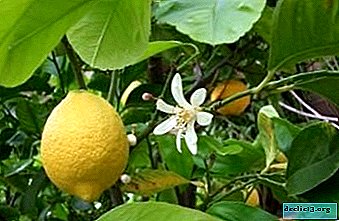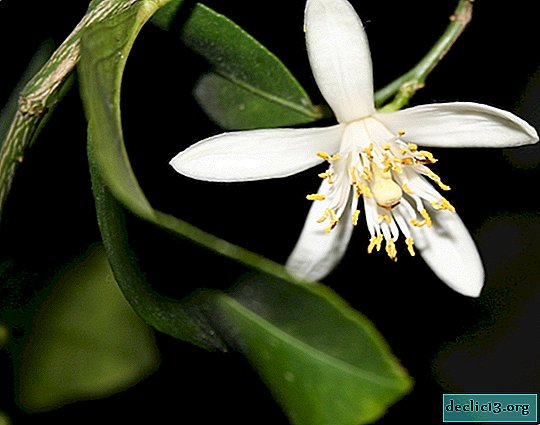Conditions for the appearance of flowers in a lemon. The nuances of care and problems of the natural process

Lemon is a popular home plant. But in order to obtain from this citrus not only attractive greens, but also ripe fruits, it is necessary to create suitable conditions for it.
The article below provides information on the conditions that must be created in order for the lemon to start blooming, the problems encountered during flowering, as well as practical tips and tricks for caring for the citrus plant.
Flowering at home
Lemons came from Southeast Asia. These are evergreen low-growing trees with shiny leathery leaves. Lemon blooms in the natural environment in the spring, and the crop can be harvested in the fall.
 At home, for the flowering of lemon, a number of conditions must be observed:
At home, for the flowering of lemon, a number of conditions must be observed:
- Provide a comfortable temperature - from 14 to 27 ° C.
- Do not move the plant from place to place.
- Position next to the window facing east. Lemons like the morning sun.
- Replanting a tree in early spring.
- Do not place near heating appliances and constantly spray to ensure sufficient humidity (about 70%).
- If pests appear, immediately dispose of the plant from them.
With such care, the lemon will delight its owners with fragrant flowering and juicy fruits.
How is the process going?
Lemon flowers are small, 2-3 cm, painted in pastel shades: white, cream, pinkish or purple. A delicate delicate aroma spreads throughout the room where the tree is located.
Principle and process
A young lemon tree may bloom in the first year of life, but such early flowering can destroy the plant. Therefore, flowers must be cut off.When does lemon blossom at home? Flowering begins, usually in late April - early May. The process of flowering lemon consists of several stages:
- The plant throws flower stalks.
- Buds form.
- The buds open after 2-3 days.
- Flowering occurs within a week.
- Petals fall and ovary occurs.
Artificial pollination and self-pollination
Lemon according to grade can either be pollinated independently or require artificial pollination. The owner of the plant can conduct the process of artificial pollination with a cotton swab or cotton wool. It is necessary to carefully transfer pollen from one flower to another. This pollination method does not guarantee high-quality pollination, but can help if there are no other options.
Number of flowers
Lemon trees produce the maximum number of flowers possible for themselves, but this is detrimental to the plant. When growing a house, you should adjust the number of flowers.
The optimal ratio would be - 1 flower on 6-7 green leaves, so that later ovaries turn into fruits.
Why are there no buds?
Lemon trees do not always delight the hosts with flowering. There can be a number of reasons for this: from improper care to the presence of pests.
Pests
Most often, lemon trees are susceptible to attacks by spider mites, scale insects, thrips and soil fleas.
Spider mite
A spider mite is a small pest that is difficult to see with the naked eye. The size of the tick is 1-2 mm, it settles on the lower side of the leaf plate, most often affects leaves and unripe shoots.
Signs of the appearance of a tick:
- Small light dots on the leaves.
- Coiled leaves with a spider web on the back.
There are several ways to get rid of a tick:
- Spraying with gray.
- Washing the leaves.
- Ultraviolet lamp.
- Processing leaves with an alcohol solution.

Shields
Scabies are the most dangerous pests. When they appear on the tree, convex oval plates (about 4 mm) appear. There are several varieties of scale insects, but all of them are equally dangerous for the plant. This pest is very difficult to get rid of, because its shell is covered with a wax shield that protects against chemicals.
For the destruction of scale insects apply:
- Chemicals (Aktara, Aktellik, etc.).
- Soapy water.
- The infusion of tobacco.

Thrips
Thrips are small insects that suck juices from lemon trees. Their appearance is easy to recognize by the silver streaks that form when the parasite moves from leaf to leaf.
For the removal of thrips use the same means as for the destruction of the spider mite.

Soil fleas (earthen fleas, podura)
In the soil where the lemon grows, podura may appear. This is a small prancing white insect with an oval body. The average flea length is 1-4 mm. The appearance of these parasites is associated with excessive irrigation and excessive soil moisture.
Earthen fleas can be seen when watering on the surface of the soil or on the pallet of the pot. Pests can actively jump in different directions. Podurs feed on decayed parts of roots and non-decayed plant debris, but easily switch to healthy roots, which can lead to the death of the plant.
By following simple rules, you can prevent these parasites from appearing:
- Keep the flower pot clean.
- Avoid excessive watering.
- Provide good drainage so that excess water does not stagnate during irrigation.
If earthen fleas have already appeared, you should:
- Reduce watering.
- Replace the topsoil in the pot (2-3) cm with new soil.
- Sprinkle the surface of the soil with dry sand.
- Sprinkle tobacco dust on the potted ground.
- Water the plant with any insecticide, and after 2-3 days, transplant the plant into new soil.

Disease
Among the diseases that affect lemon, late blight and soot fungus.
- Late blight (late blight) is one of the most common diseases of citrus plants. It can go from one plant to another. The disease manifests itself with brown spots located along the central vein of the leaf. Spots can be covered with a coating similar to a web.
If the disease has just begun, removing the affected parts of the plant will help. For advanced cases, Albit, Profit or Ordan are used.
- Soot fungus often occurs due to damage to the plant by scabies.
Therefore, it is necessary to carefully inspect the plant for pests. If pests have been detected, immediate action is required.
The photo shows late blight:

The photo shows a soot fungus:

Violation of the conditions of detention
Unsuitable conditions in which lemon tree grows are often the reason for the lack of flowering. The main errors in the conditions of detention:
- Excessive / insufficient watering. It is necessary to maintain moderate soil moisture
- High / low soil pH. Lemons like a neutral pH.
- Fertilizer in the winter. Feeding a lemon is recommended only in the summer.
- High temperature in the room. Lemon trees prefer average temperature but high humidity.
- Dry air is fatal to lemon
- Inadequate lighting.
What to do and how to make the plant produce buds?
If a lemon tree does not bloom for a long time, it can be provoked to bloom by proven methods:
- Creation of extreme conditions:
- In winter, the lemon can be taken out to the balcony to make the plant wake up.
- The second way to change the conditions is to intentionally create a period of drought, which is replaced by abundant watering.
- Crown formation. Lemon trees begin to bloom and bear fruit on branches of 3-4 orders. By molding, you can push the plant to active branching and the appearance of the necessary branches. It is important to make molding correctly and not to cut short fruit twigs. In addition, pinching helps to form a beautiful crown of a tree.
- Pulling branches. Improvising with a rope and weights, you can give the branches a horizontal position. This leads to faster flowering and fruiting. Skeletal branches can be pulled by wire.
- Necessary care measures. The plant needs:
- Timely feed (only in the summer season).
- Pour with settled water.
- Spray often to create a comfortable environment that allows the lemon tree to grow stronger and gain strength for flowering.
We suggest watching a video on how to help lemon blossom:
What if they appeared?
Active blooming of a lemon does not guarantee that ovaries and then fruits form on the plant. Why can flowers fall? In the absence of proper care for a flowering lemon, flowers may fall from him. This happens if:
- Air temperature is above 18 ° С.
- The soil in which the tree grows is overdried.
- The air is not humidified enough.
- The plant is watered with water that contains chlorine.
Why are there flowers and no ovaries and fruits? In addition, the presence of flowers does not always mean that the lemon will bear fruit. The main reasons for the lack of fruiting:
- Un dusted flowers.
- Violation of the conditions of the plant.
- The age of the tree. A young plant is not able to bear fruit.
Photo
Next, you can see the photo of a blooming lemon:





Application
Lemon tree is valued not only because of the fruit. Inflorescences of lemons are actively used in cooking and traditional medicine. Lemon flowers in cooking are used not only as a decor. In the East, they are used in the preparation of desserts. Flower lemon water is popular in Europe. It is used as the basis for various cocktails.
In folk medicine, lemon inflorescences are used:
- With insomnia and menstrual pain.
- With hypertension and emotional arousal.
- With nausea and pain in the stomach.
- When coughing.
Lemon trees are not only beautiful ornamental plants. With proper care of the lemon, regular flowering and fruiting can be achieved. Flowering will provide a pleasant aroma in the room, inflorescences can be used in cooking or medicine, and ripened fruits can be eaten. The efforts made to grow a lemon are fully paid for by its beauty and fruits.

















